All About Prosthodontists
Occupation Description Construct oral prostheses to replace missing teeth and other oral structures to correct natural and acquired deformation of mouth and jaws, to restore and maintain oral function, such as chewing and speaking, and to improve appearance.
A Day in the Life of a Prosthodontist
- Design and fabricate dental prostheses, or supervise dental technicians and laboratory bench workers who construct the devices.
- Use bonding technology on the surface of the teeth to change tooth shape or to close gaps.
- Treat facial pain and jaw joint problems.
- Measure and take impressions of patients’ jaws and teeth to determine the shape and size of dental prostheses, using face bows, dental articulators, recording devices, and other materials.
- Replace missing teeth and associated oral structures with permanent fixtures, such as implant-supported prostheses, crowns and bridges, or removable fixtures, such as dentures.
- Fit prostheses to patients, making any necessary adjustments and modifications.
Featured schools near , edit
Things a Prosthodontist Should Know How to Do
When polled, Prosthodontists say the following skills are most frequently used in their jobs:
Active Listening: Giving full attention to what other people are saying, taking time to understand the points being made, asking questions as appropriate, and not interrupting at inappropriate times.
Speaking: Talking to others to convey information effectively.
Social Perceptiveness: Being aware of others’ reactions and understanding why they react as they do.
Critical Thinking: Using logic and reasoning to identify the strengths and weaknesses of alternative solutions, conclusions or approaches to problems.
Complex Problem Solving: Identifying complex problems and reviewing related information to develop and evaluate options and implement solutions.
Monitoring: Monitoring/Assessing performance of yourself, other individuals, or organizations to make improvements or take corrective action.
Types of Prosthodontist
- Oral Maxillofacial Prosthodontist
- Prosthodontist/Owner
- Prosthodontist, Assistant Clinical Professor
- Maxillofacial Prosthodontist
- Doctor of Dental Science, Prosthodontist
Job Demand for Prosthodontists
In the United States, there were 900 jobs for Prosthodontist in 2016. New jobs are being produced at a rate of 22.2% which is above the national average. The Bureau of Labor Statistics predicts 200 new jobs for Prosthodontist by 2026.
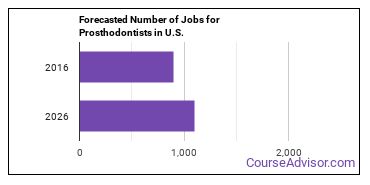
The states with the most job growth for Prosthodontist are Oregon, Indiana, and Washington. Watch out if you plan on working in Washington, Indiana, or Oregon. These states have the worst job growth for this type of profession.
What is the Average Salary of a Prosthodontist
Prosthodontists make between $103,240 and $208,000 a year.
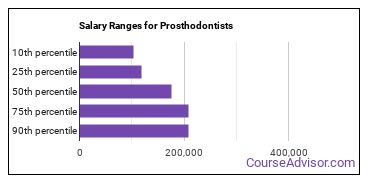
Prosthodontists who work in Florida or Virginia, make the highest salaries.
How much do Prosthodontists make in each U.S. state?
| State | Annual Mean Salary |
|---|---|
| Florida | $217,410 |
| Virginia | $190,340 |
What Tools do Prosthodontists Use?
Although they’re not necessarily needed for all jobs, the following technologies are used by many Prosthodontists:
- Henry Schein Dentrix
- Patterson Dental Supply Patterson EagleSoft
- Henry Schein DentalVision Professional
- Henry Schein Easy Dental
- Kodak Dental Systems Kodak PRACTICEWORKS Practice management software PMS
Becoming a Prosthodontist
What kind of Prosthodontist requirements are there?
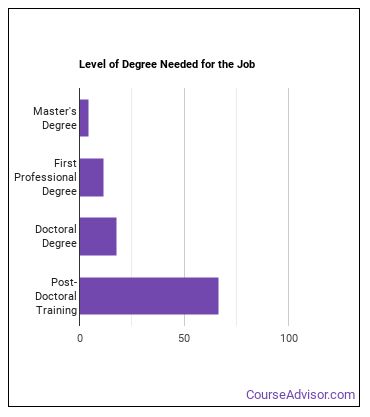
What work experience do I need to become a Prosthodontist?
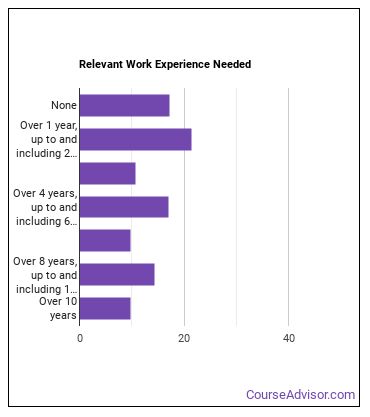
Where Prosthodontists Work
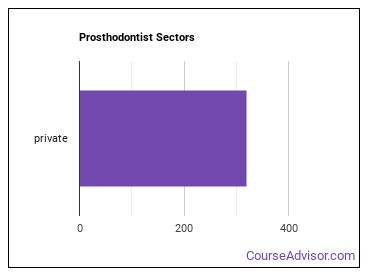
Prosthodontists work in the following industries:
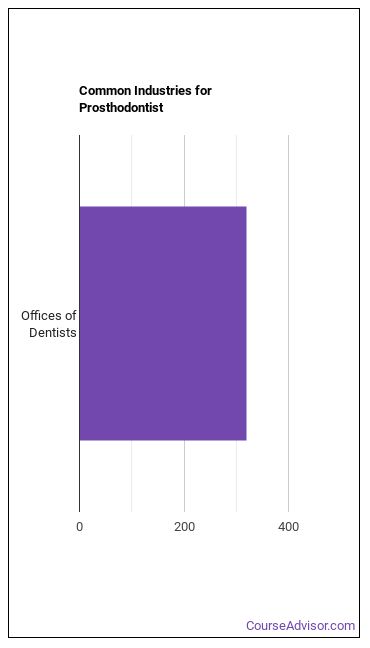
References:
Image Credit: Airman 1st Class Amy Perry via Public domain
More about our data sources and methodologies.
Featured Schools
 Request Info
Request Info
|
Southern New Hampshire University You have goals. Southern New Hampshire University can help you get there. Whether you need a bachelor's degree to get into a career or want a master's degree to move up in your current career, SNHU has an online program for you. Find your degree from over 200 online programs. Learn More > |
